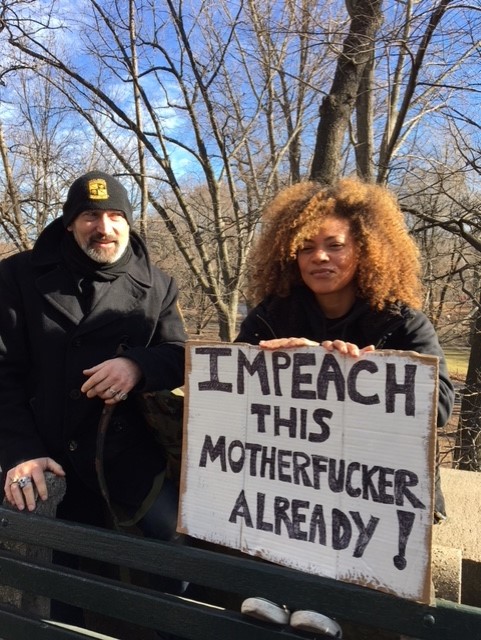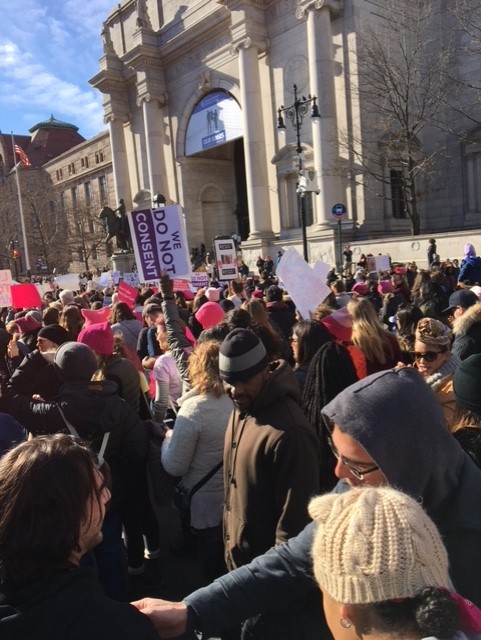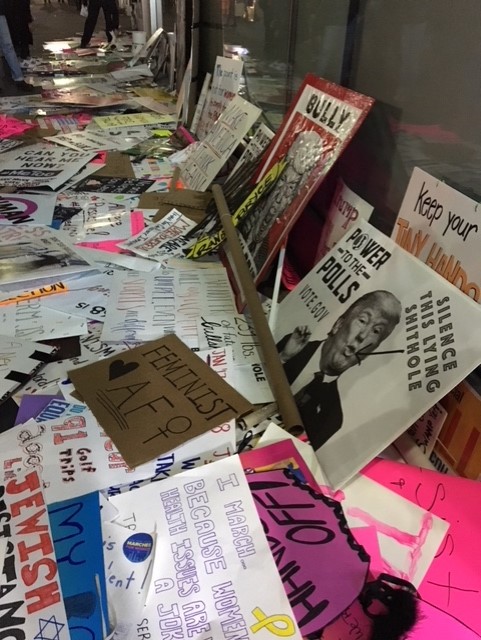New York City
Women’s March in NYC



My friend was holding a coffee from Joe’s. It was noon. I said I wanted coffee from the $2 place. We were on Columbus and 86th Street, heading for the march.
The Red Impala
Nunez, Calderon, and Luis (that’s me), we found an old Chevy Impala, a real big one from the Fifties. It was in the sandbox in front of the kids’ playground next to the project in which we lived. Calderon is very smart. He got a job selling bets at OTB, and we really trusted his judgment. “Nunez, Luis,” he said, “the car has no plates on it. The radio and battery are gone. It is safe to assume that it is abandoned.”
Posts from el Barrio
Trump & Mi Gente
I’m still “Seeing Red” after reading all the Moronic comments on Trump….There are an incredible number of fucking Closet Nazis out there.
Arnold Weinstein: The Magical Use Of Language
Arnold and I were talking about the modern world. He thought a moment and then said, “History is a thing of the past.” The comedic surface of that remark, coupled with its profound undertones, was typical of his extraordinary mind.
Pimpology
True story # 1: It’s a late spring Thursday in New York City in the late ‘70s and I’m a kid in high school. For reason I can’t recall, the entire student body was dismissed at noon. A halfaday!
Free! What to do? What to do? My pal Joel has an idea. He opens his copy of the New York Post–yes, we read newspapers back then–to the movie section and points to a small ad. It’s the final day of Pam Grier film festival at the RKO Warner in Times Square. Yes, indeedy, five, count ‘em, five of her finest efforts–Coffy, Foxy Brown, Bucktown, Sheba Baby and Friday Foster–for the price of one three dollar ticket.
Edwin Denby
George Schneeman, Edwin Denby, 1977, fresco on cinder block. Private Collection, New York
Once when we were having lunch at the Oyster Bar in Grand Central Station, I complained to Edwin about hearing myself on a tape of some recent poetry reading. “Yes,” Edwin said matter-of-factly in his customarily soft, slightly gravelly voice, “that resentment tone.” Thinking back on it over the years, I may not have understood the intriguingly commiserating aspect of Edwin’s remark.
Roots Moves
“Loss of the past, whether it be collectively or individually, is the supreme human tragedy, and we have thrown ours away just like a child picking off the petals of a rose… We owe our respect to a collectivity, of whatever kind—country, family or any other—not for itself, but because it is food for a certain number of human souls.”—Simone Weil, “The Need for Roots”
Simone Weil once lived in a building around the corner from Tiemann Place in West Harlem where we held our 29th annual “Anti-Gentrification Street Fair” in October.
Hail Atlantis: A Sandy Survivor’s Tale
On the morning of October 29, 2012, I get a phone call from Surfer Laura. She’s adamant, “Donna, Don’t leave!!” Like all my neighbors, she urges me to stick it out. The overly-hyped Hurricane Irene of the previous season had left Long Beach residents somewhat skeptical. Lots of drama and then…nothing. “Stay put, they won’t let you back in, they’ll close the parkways, there could be looting, you won’t be able to get home.” Laura’s warning is echoed across town. Civitas Ad Mare, situated between the mighty Atlantic and Reynold’s Channel, our precious City by the Sea is under siege. Who else but us, the water people of the Earth will stand strong to defend it? No sweat, I remind Laura, “I’m a Rockaway girl. We don’t back down.”
America by Birth, Rockaway by the Grace of God: A New York Surf Story
For people who grew up on the Rockaway Peninsula, the gradual loss of our homeland was as senseless as it was staggering. Once a shimmering seaside summer haven for New York’s working families, over time huge chunks of our coastal “Everyman’s paradise” fell to ruin. Across this geographically isolated barrier reef on the southeast Queens, miles of waterfront property were transformed into desolate urban wastelands – for nothing. Everyone has an opinion. Some blame the City of New York for piss-poor urban planning policies. Others claim an accelerated influx of impoverished minority populations transformed Rockaway into “Welfare-by-the-Sea.” Or was it white flight that pushed things to the tipping point? By all accounts, Rockaway’s history has been a perfect shit storm. But perfect storms also bring awesome waves. Somehow, through it all, across the Peninsula, four generations of surfing dynasties survived.
Harlem: The New Frontier?
‘Harlem is the last great frontier of Manhattan real estate,’ gushes Barbara Corcoran, manager of an elite New York real estate brokerage. ‘There are many wonderful things happening in this historic and beautiful area.’ Others are calling it the new Harlem Renaissance.
Wonderful things do happen in Harlem but gentrification isn’t one of them. Since the city’s real estate market exploded in 1996, Harlem has had a bull’s eye on its back as brokers and developers have made fortunes buying and selling brownstones for renovation. Victorian mansions have been gutted, and refitted with intricate wooden staircases and period chandeliers; black professionals, white gays, students and many others have followed the developers, desperate to find a place to live in a borough where last year the average apartment price was recorded at $770,000. 125th Street (which no-one calls Martin Luther King Boulevard) has been reinvented as a suburban mall. Gone are many of the street vendors and small shop owners, replaced by the large logo stores such as Disney and Old Navy. The jewel in the crown is the mall, ‘Harlem USA.’ And a new first run movie theater, thanks to Magic Johnson’s real estate company.
